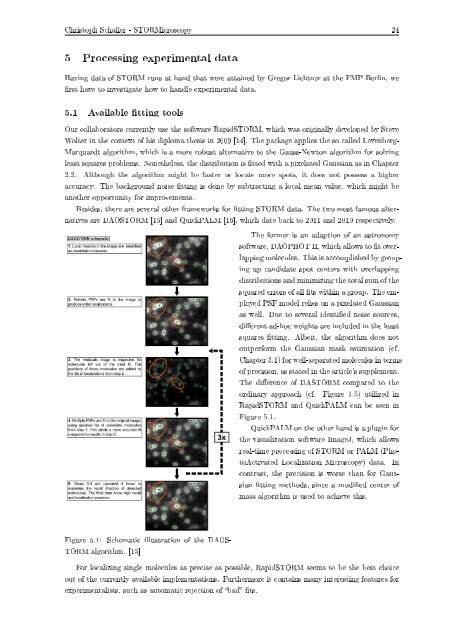Christoph Florian Schaller - FU Berlin, FB MI
Christoph Florian Schaller - FU Berlin, FB MI
Christoph Florian Schaller - FU Berlin, FB MI
Create successful ePaper yourself
Turn your PDF publications into a flip-book with our unique Google optimized e-Paper software.
<strong>Christoph</strong> <strong>Schaller</strong> - STORMicroscopy 24<br />
5 Processing experimental data<br />
Having data of STORM runs at hand that were attained by Gregor Lichtner at the FMP <strong>Berlin</strong>, we<br />
rst have to investigate how to handle experimental data.<br />
5.1 Available tting tools<br />
Our collaborators currently use the software RapidSTORM, which was originally developed by Steve<br />
Wolter in the context of his diploma thesis in 2009 [14]. The package applies the so called Levenberg-<br />
Marquardt algorithm, which is a more robust alternative to the Gauss-Newton algorithm for solving<br />
least squares problems. Nonetheless, the distribution is tted with a pixelated Gaussian as in Chapter<br />
2.2. Although the algorithm might be faster or locate more spots, it does not possess a higher<br />
accuracy. The background noise tting is done by subtracting a local mean value, which might be<br />
another opportunity for improvements.<br />
Besides, there are several other frameworks for tting STORM data. The two most famous alternatives<br />
are DAOSTORM [15] and QuickPALM [16], which date back to 2011 and 2010 respectively.<br />
The former is an adaption of an astronomy<br />
software, DAOPHOT II, which allows to t overlapping<br />
molecules. This is accomplished by grouping<br />
up candidate spot centers with overlapping<br />
distributions and minimizing the total sum of the<br />
squared errors of all ts within a group. The employed<br />
PSF model relies on a pixelated Gaussian<br />
as well. Due to several identied noise sources,<br />
dierent ad-hoc weights are included in the least<br />
squares tting. Albeit, the algorithm does not<br />
outperform the Gaussian mask estimation (cf.<br />
Chapter 3.1) for well-separated molecules in terms<br />
of precision, as stated in the article's supplement.<br />
The dierence of DASTORM compared to the<br />
ordinary approach (cf. Figure 1.5) utilized in<br />
RapidSTORM and QuickPALM can be seen in<br />
Figure 5.1.<br />
QuickPALM on the other hand is a plugin for<br />
the visualization software ImageJ, which allows<br />
real-time processing of STORM or PALM (PhotoActivated<br />
Localization Microscopy) data. In<br />
contrast, the precision is worse than for Gaussian<br />
tting methods, since a modied center of<br />
mass algorithm is used to achieve this.<br />
Figure 5.1: Schematic illustration of the DAOS-<br />
TORM algorithm. [15]<br />
For localizing single molecules as precise as possible, RapidSTORM seems to be the best choice<br />
out of the currently available implementations. Furthermore it contains many interesting features for<br />
experimentalists, such as automatic rejection of bad ts.









